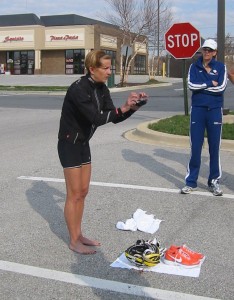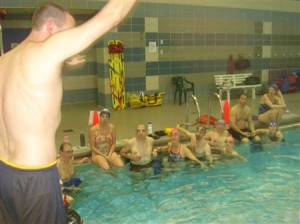I signed up for a March Madness training weekend with the Annapolis Triathlon Club, fondly known as Iron Crabs, and when I looked at the itinerary thought I might well be ‘mad’ for what I was getting myself into. Two members of the team had coordinated with various area coaches and facilities so that we could have an entire weekend of biking, running, swimming, and education at our fingertips. My goal in signing up was to get a true evaluation of where I am in my own training and to immerse myself in three days of all things triathlon.Each of the three days warrants its own post and in due time I will get them up. The weekend was incredibly valuable and I was a total sponge listening to experienced triathletes and coaches as they shared advice, tips, and techniques for improving work-outs and efficiency in both training and racing. There were about 20 people in total participating in the weekend’s events and being with other triathletes of all skill levels was very enlightening as it was exciting to share the experience with both new and veteran triathletes. The nutshell recap of the weekend is this:
Testing Run Performance
Recently I wrote about my quest to set and also be able to adjust a race pace goal and Friday night of the March Madness weekend was lead by Iain Banks, head coach of Endurance Junkie Coaching who set up run tests that were very timely given my recent post. We did two performance tests–one measured our maximum velocity and the other was a measurement of our strength and stride. We did each test three times and the running coaches recorded our times so that we can continue the tests throughout the season and have a starting point to measure from. To measure our maximum velocity we did a 30-meter sprint from a flying start. The first run I did in 4.4 seconds; the second in 4.8 seconds; and the third in 4.6 seconds. Thankfully Iain did the first round of math for us and the calculations show that my maximum velocity is currently 409 meters/minute. This can be used to calculate a new target race pace as well as a minute/mile pace (I need to figure out the math on how to make these calculations). Ideally with training and speedwork my max velocity will increase and I can shoot for a faster race pace.
The second test measured our sprint bounding index (SBI). For 30 meters we bounded. This test was entertaining at best as most of us don’t typically incorporate bounding into our work-outs. The movement was familiar to me from a drill I vaguely recall from high school track but my performance would indicate that I’ve never bounded before in my life. The idea is to move from one end of a 30-meter mark to the other in smooth forward but upward movements as fast as possible. By counting the number of bounds and the time it takes to cover 30 meters you can generate the SBI. The first run I did with 11 bounds, 7.2 seconds; the second took 12 bounds, 7.5 seconds; and the third took 14 bounds, 7.3 seconds. My SBI index (bounds/time) was 79.2. With practice, the 30 meters should be done with less bounds and in faster time. The movement also requires strength and power and Iain recommended adding sprinting bounds to work-outs; for example, at the end of a track work-out, incorporate 30 meters of bounding and gradually build to 100 meters.
A Long Ride & The Importance of Stretching
Saturday morning we met bright and early at the Bike Doctor of Annapolis for coffee, bagels, and a session of cycling specific stretching. Judy Acosta, a licensed massage therapist and fellow ATC member, led the stretching along with Stu Waring who is an absolute wealth of cycling knowledge. This is one of the topics that will require me to go into more detail but in short–STRETCH–specifically the hip flexors and hamstrings. Dynamic stretching remains the current preference for pre-ride stretches and static, muscle-specific stretching is critical for maintaining flexibility and is done post-ride.
After our stretching session and bike tune-ups (my drive train was evidently a mess and my chain needed lube so a huge ‘thank you’ to Bike Doctor’s mechanic for the tune-up) we geared up and rallied in the parking lot for a pre-ride brief. There were two options for the day: a 35 mile loop or a longer 46 mile loop. With 25 miles being the farthest I’ve ever ridden I opted for the 46 loop of course! I will definitely go into detail about this ride in a different post but suffice it to say it was an incredible learning experience, a challenging but worthwhile ride, and an introduction to group riding which I cannot wait to do more often.
Post-ride we all got lunch together to debrief the ride and it was invigorating and motivating to be around so many other people just as addicted to this stuff as I am.
Transition Set-Up & Brick Practice
The weekend finished up with a focus on transitions as well as the first leg of any triathlon, the swim. We started by simply talking about setting up a transition area at a race. Something that at first thought might seem simple enough really has a lot of details that can be taken into account in order to make transitions smooth and efficient. Some quick tips (though this transition session is yet another separate post):
- Get a super bright towel or mat to put your stuff on so that you can easily spot your area during transitions
- If wearing socks, roll them 3/4 of the way down so they are easier to slide onto wet feet
- Put your helmet with sunglasses in it face up on the ground next to your shoes rather than on your bike; easier to grab and get on
- Practice clipping in and clipping out over and over and over and over
We set out on a 21 mile training ride that was hands down my personal best and fastest ride yet. I’m slowly but surely getting more comfortable on my bike and the best part is that I’m now enjoying biking rather than thinking of it as something I have to do for triathlon. It still seems to me there’s much more to biking than running, but I think part of why I like it more is that I’ve realized how much there is to learn. The ride included some great rolling hills, more group ride, pace line, and drafting practice, tours past plenty of roadkill, a near collision with a squirrel, and finished with a killer uphill that took its toll on me during last year’s Ben Moore Memorial Half Marathon.
From there we swapped shoes and headed out for a short run. I did a little over 3 miles in about 25 minutes and though my pace felt slow and choppy, for the first brick of the season it was a pretty decent session. The transition session and brick practice was led by Coach Ashley Halsey who is also the president of the ATC and Coach Kerri Robbins; they run Kinetic Motion Sports and are extremely experienced in all things triathlon. Their tips and encouragement throughout the day and weekend were hugely helpful and a great indicator of the value of having a coach dedicated to helping you meet your specific goals. I’ve never had a coach at my fingertips like I did this weekend and it makes me seriously consider the investment as I seek to improve my performance.
Triathlon Swimming
The March Madness weekend finished with a swim session led by David Wendkos who had blocked four lanes at the Riva Swim Center for our group. We met first for ‘chalk talk’ (minus the chalk) and covered everything from de-fogger to wetsuits to using fins while training to the importance of establishing balance in the water. David shared lots of great information (again, watch for a future post) and one of the things that struck me as an ‘ah ha!’ moment was the tip to put your goggles on under your swim cap so that if you get knocked while in the water you won’t lose your goggles. Brilliant!
In the pool David had us do a series of drills intended to help create the necessary balance to swim efficiently. We practiced kicking and various stroke and breathing drills. I’ve been on the hunt for some new drills so this was a huge take-away for me to be able to incorporate new swim drills into my work-outs. At one point, all of us were in two lanes and we practiced a group start. It’s not very often you get the chance to experience a group start in a controlled setting. I learned pretty quickly that I am the one who hangs back for a second in order to have a clean start; then I find my path and swim. We also got advice on how to round a buoy as well as the chance to practice those moves. I can’t say I ever thought much about my buoy rounding technique but it’s yet another thing that can be done more efficiently during a race.
We were also videoed and will soon have the chance to see ourselves swim so I am very eager to see and share the results of being ‘caught on film’ while swimming.
March Madness
The March Madness tri training weekend was incredible. I was completely exhausted at the end of each day and can only imagine what it’s like to be a professional athlete at week-long camps that are much more intense than what we experienced. I got what I wanted out of the weekend and much, much more.
I learned that I am in better shape than I thought. I learned that the only way I will get better, faster, and stronger at biking is to do more of it and to focus on the things I learned this weekend. I learned that I love group rides and the opportunity to be challenged by riding with others who are better than me. I learned that I can be a more efficient swimmer, which will hopefully make me faster. I realized I am very grateful to still have 15 more training weeks before my own 70.3 event so that I can practice what I’ve learned.
And I learned that I still have a lot to learn! I’ll use this post to say thank you again to all the coaches and all the others who participated for making March Madness an awesome training weekend!




